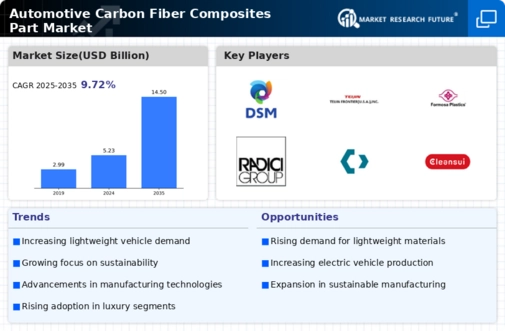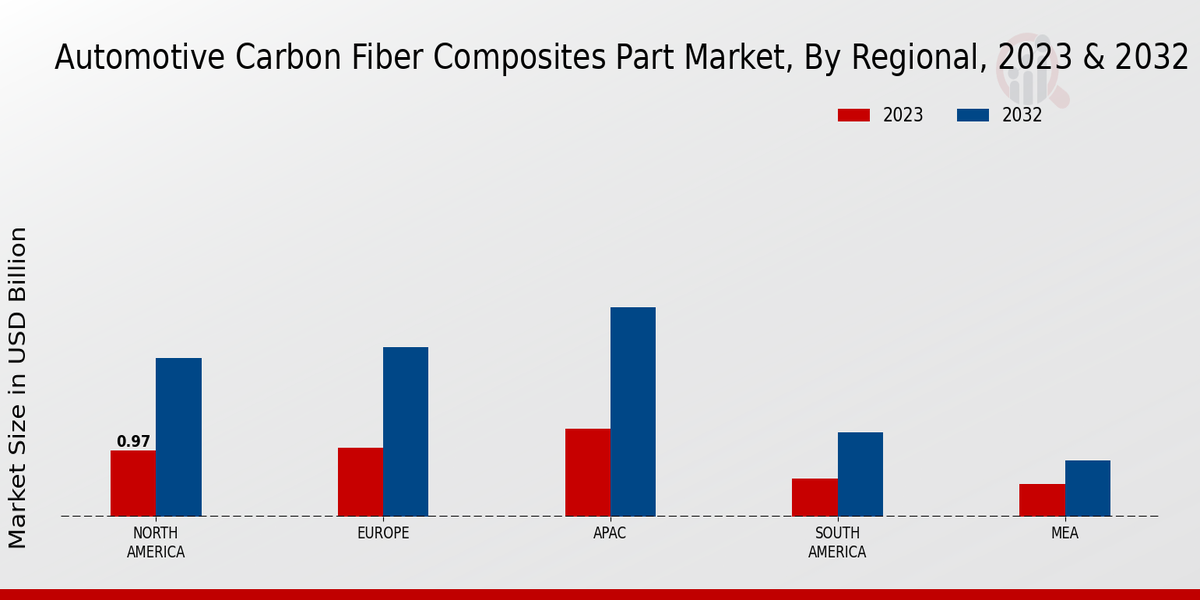Market Growth Projections
The Global Automotive Carbon Fiber Composites Part Market Industry is poised for substantial growth, with projections indicating a market size of 5.23 USD Billion in 2024 and an anticipated expansion to 14.5 USD Billion by 2035. This growth trajectory suggests a compound annual growth rate of 9.72% from 2025 to 2035, reflecting increasing adoption of carbon fiber composites across various automotive applications. Factors contributing to this growth include rising demand for lightweight materials, advancements in manufacturing technologies, and regulatory support for sustainable practices. The market's evolution is likely to be shaped by ongoing innovations and the automotive industry's shift towards more efficient and environmentally friendly solutions.
Growing Demand for Lightweight Materials
The Global Automotive Carbon Fiber Composites Part Market Industry is experiencing a surge in demand for lightweight materials, driven by the automotive sector's emphasis on fuel efficiency and performance. Carbon fiber composites, known for their high strength-to-weight ratio, are increasingly utilized in vehicle manufacturing. In 2024, the market is projected to reach 5.23 USD Billion, reflecting a growing preference among manufacturers to reduce vehicle weight. This trend is further supported by regulatory pressures aimed at lowering emissions, which compel automakers to adopt advanced materials that enhance fuel economy without compromising safety or performance.
Increasing Adoption in Electric Vehicles
The rise of electric vehicles (EVs) is a pivotal driver for the Global Automotive Carbon Fiber Composites Part Market Industry. As automakers strive to enhance the range and efficiency of EVs, the lightweight properties of carbon fiber composites become increasingly attractive. These materials help offset the weight of heavy battery systems, thereby improving overall vehicle performance. The shift towards EVs is anticipated to accelerate market growth, with carbon fiber components becoming integral to vehicle design. This trend aligns with the broader automotive industry's transition towards sustainable practices, further solidifying the role of carbon fiber in future vehicle architectures.
Regulatory Support for Sustainable Practices
Regulatory frameworks promoting sustainability are significantly impacting the Global Automotive Carbon Fiber Composites Part Market Industry. Governments worldwide are implementing stringent emissions standards and incentivizing the use of eco-friendly materials in automotive manufacturing. This regulatory support encourages manufacturers to explore carbon fiber composites as viable alternatives to traditional materials. The potential for reduced environmental impact, coupled with the performance benefits of carbon fiber, positions it as a favorable option for compliance with evolving regulations. As the automotive industry adapts to these changes, the demand for carbon fiber composites is likely to increase, driving market growth.
Rising Investment in Research and Development
Investment in research and development (R&D) is a crucial factor propelling the Global Automotive Carbon Fiber Composites Part Market Industry. Companies are allocating significant resources to explore innovative applications of carbon fiber in automotive design and manufacturing. This focus on R&D aims to enhance the performance characteristics of carbon fiber composites, making them more competitive against alternative materials. As manufacturers seek to differentiate their products in a crowded market, advancements in composite technology are expected to yield new opportunities for growth. The anticipated compound annual growth rate of 9.72% from 2025 to 2035 underscores the potential of R&D-driven innovations in shaping the future of the market.
Technological Advancements in Manufacturing Processes
Technological innovations in the production of carbon fiber composites are significantly influencing the Global Automotive Carbon Fiber Composites Part Market Industry. Advanced manufacturing techniques, such as automated fiber placement and resin transfer molding, are enhancing the efficiency and scalability of carbon fiber production. These advancements not only reduce costs but also improve the quality and consistency of composite parts. As a result, manufacturers are increasingly integrating carbon fiber components into their vehicles, contributing to the market's projected growth. By 2035, the market is expected to expand to 14.5 USD Billion, indicating a robust trajectory fueled by these technological improvements.









